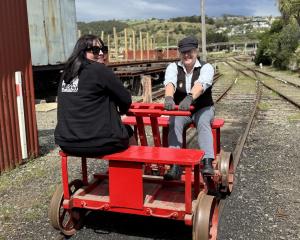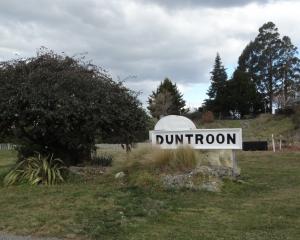Erosion is threatening the coastal road between Oamaru and Kakanui, but community members are adamant this should not be the end of the road for the spectacular scenic route popular with locals, surfers and tourists. Rebecca Ryan reports.
It is obvious the coastal road between Oamaru and Waianakarua is much more than just a transport link.
The road, which hugs the spectacular North Otago coastline between Oamaru and Kakanui and beyond, has special appeal to surfers and tourists alike.
Like many areas of coastal New Zealand, it is plagued by erosion. It is a natural process, but where is the line between letting nature take its course and stepping in at great expense to protect a North Otago community asset? The road's future has been under scrutiny for about 14 years and has been included in two draft coastal road strategies produced by the Waitaki District Council, in 2010 and again last year.
Last year's draft strategy outlined the difficulties in keeping the coastal route open indefinitely.
While the Waitaki District Council recognised the importance of the coastal route from Oamaru to Kakanui and Waianakarua, it said expenditure must be weighed in terms of the cost to the district and its long-term affordability. A major slip on May 10 again highlighted the issue with a section of Beach Rd north of Kakanui closed for a week. It is now open as a single lane.
Coastal road community group chairman Peter Amyes said he did not believe that particular slip was a direct result of coastal erosion, but it was an issue affecting the 23.8km road, and decisions on its future needed to be made with some urgency.
Mr Amyes said the council had, to some extent, been sitting on its hands over the coastal erosion issue and as a result the cost of protection had increased sixfold.
''They should be retaining these roads, they should be building infrastructure, not just letting it slip away,'' he said.
''One of the problems of not making a decision, is that while they have been sitting for 14 years, the sea has been eroding at it.''
Of the 23.8km road, about 600m was susceptible to erosion in the next 10 or 20 years, he said.
There were areas where some successful rock protection work had been completed at minimal expense, he said.
The coastal road community group's last meeting at the Kakanui Hall attracted more than 130 people.
''Everyone wants to keep that road open, it's just a matter of how do we deal with the problem of coastal erosion and how do we deal with the cost of maintaining the road open?'' he said.
Mr Amyes hesitated to use the word ''iconic'' to describe the coastline, but did call it unique.
''It's one of the few areas of coastline which has a good sealed road that goes down it. From a tourist perspective - it's high value,'' he said.
''It's not particularly well advertised, but if it was advertised more and better and we were getting more tourists down it staying for an extra day or half-day, they're spending more money in Oamaru and in the local area.''
The New Zealand Automobile Association and police had also highlighted the road's importance in providing access for emergency services, he said.
''If State Highway 1 closes, which it has done a couple of times in the last month or so for floods at Maheno and a road crash just south of Waianakarua, this is a very viable alternate route,'' he said.
''Then you've got access to the farming community and businesses. If they closed the route down, how would Kakanui survive?''
As for the local community, you cannot put a price on the stretch of coastal road. They say it is New Zealand's answer to Australia's Great Ocean Road, right here in North Otago.
In five minutes, Oamaru's scene dramatically changes, from an urban setting to golden beaches, wide open spaces and lush green on the roadside. Even in colder months the drive is a visually terrific one.
''It's kind of mind-blowing. We've got this pristine landscape and it's five minutes from an urban area,'' Oamaru man John Baster said.
''For tourists, you can't put a price on it.''
Oamaru surfers Jeremy Holding and Phil Scott are filled with anticipation each time they turn on to Beach Rd to see how big the surf is. It is a route they have taken since they were teenagers.
They both had always appreciated what North Otago had to offer along the coastal road, but the secret was out now, they said, as the region had built a reputation for being a unique, coastal tourism hot spot.
''When I left Kakanui, you could buy a house for $20,000. Certainly not any more. That's partly because of the coastal road, and what it gives to Kakanui,'' said Mr Scott, who brought his business, Scotts Brewery, to Oamaru from Auckland last year.
Mr Holding, who owns Soul Surf and Skate in Oamaru, said he had noticed a huge shift in attitude in the past 10 years.
Now, he has tourists walking into his business off the street having stopped in the town to see the pristine coastline.
''Without that coast road for locals and tourists, the place wouldn't be the same,'' he said.
''I drive out there to the beach every day, but every time I go to Dunedin I go that way it's way nicer and it's more interesting, that's for sure.''
Protection of the coastline to keep the coastal road open was paramount for the region's future in tourism, they said.
''Do the research, do the structuring and make sure it stays there for the next 100 years,'' Mr Scott said.
''There are some great engineering solutions, it's about choosing the right one and making it cost-effective.
''Even though it's costing us time and money, it's making us aware of our assets. We have got a good thing, let's do something about it. It's bringing people together.''
Coast Cafe owner Richard Collins agreed the coastal road was an integral part of the tourism network.
''I'm regularly getting feedback from national and international tourists who walk into the restaurant, look out the window and just go: `Wow','' he said.
Mr Collins and his family moved to Oamaru three years ago after their food business and accommodation were destroyed in the Christchurch earthquake of September 2010.
In three years, Mr and Mrs Collins had been proud to make Kakanui's Coast Cafe somewhere locals could be proud of.
''Everything we do is in keeping with the simplicity of the thing that we have, which is just making it all about the view out the window and having food that complements that,'' he said.
Mr Collins believed his business would survive no matter what the future of the coastal road was.
''As long as there's a way to get here, we're strong enough to carry on regardless, but it's preferable that [customers] can come along Beach Rd,'' he said.
There was a sense of sadness in the Kakanui community at the thought of losing that route. The recent slip had highlighted issues, and it was an interesting regional case study of global warming, he said.
''Strategic planning as opposed to knee-jerk postevent reactions is certainly the way forward.
''It's not going to get any cheaper, so investment now could financially be a better option than [spending] whenever we have our hand forced.''
The erosion threat to the coastal road was an issue the new Waitaki District Council had inherited, but Mayor Gary Kircher said he felt progress was being made.
After the recent slip on Beach Rd, Mr Kircher, Cr Bill Kingan and assets manager Neil Jorgensen assessed other trouble spots along the coastal road and noted how protection work had made a significant difference.
There would be areas, particularly cliff-top ones, where protection solutions would be beyond the council's means, he said.
''The end goal that we're all after is to be able to keep that road open. We're trying to preserve as much of the road as we can at a cost we can afford.''
Other options the council was considering included moving the road further inland and strengthening inland routes.
The community-based coastal roads group had helped focus council attention on the important aspects of a long-term strategy, using some common sense and local knowledge, Mr Kircher said.
''Something is being done and we will have a plan,'' he said.
The challenge now was to get NZTA funding for protection work, he said.











